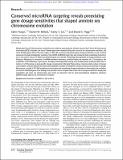| dc.contributor.author | Bellott, Daniel W. | |
| dc.contributor.author | Naqvi, Sahin | |
| dc.contributor.author | Lin, Kathy S. | |
| dc.contributor.author | Page, David C | |
| dc.date.accessioned | 2018-07-05T14:03:40Z | |
| dc.date.available | 2018-07-05T14:03:40Z | |
| dc.date.issued | 2018-02 | |
| dc.date.submitted | 2017-09 | |
| dc.identifier.issn | 1088-9051 | |
| dc.identifier.issn | 1549-5469 | |
| dc.identifier.uri | http://hdl.handle.net/1721.1/116787 | |
| dc.description.abstract | Mammalian X and Y Chromosomes evolved from an ordinary autosomal pair. Genetic decay of the Y led to X Chromosome inactivation (XCI) in females, but some Y-linked genes were retained during the course of sex chromosome evolution, and many X-linked genes did not become subject to XCI. We reconstructed gene-by-gene dosage sensitivities on the ancestral autosomes through phylogenetic analysis of microRNA (miRNA) target sites and compared these preexisting characteristics to the current status of Y-linked and X-linked genes in mammals. Preexisting heterogeneities in dosage sensitivity, manifesting as differences in the extent of miRNA-mediated repression, predicted either the retention of a Y homolog or the acquisition of XCI following Y gene decay. Analogous heterogeneities among avian Z-linked genes predicted either the retention of a W homolog or gene-specific dosage compensation following W gene decay. Genome-wide analyses of human copy number variation indicate that these heterogeneities consisted of sensitivity to both increases and decreases in dosage. We propose a model of XY/ZW evolution incorporating such preexisting dosage sensitivities in determining the evolutionary fates of individual genes. Our findings thus provide a more complete view of the role of dosage sensitivity in shaping the mammalian and avian sex chromosomes and reveal an important role for post-transcriptional regulatory sequences (miRNA target sites) in sex chromosome evolution. | en_US |
| dc.publisher | Cold Spring Harbor Laboratory Press | en_US |
| dc.relation.isversionof | http://dx.doi.org/10.1101/gr.230433.117 | en_US |
| dc.rights | Creative Commons Attribution 4.0 International License | en_US |
| dc.rights.uri | http://creativecommons.org/licenses/by/4.0/ | en_US |
| dc.source | Cold Spring Harbor Laboratory Press | en_US |
| dc.title | Conserved microRNA targeting reveals preexisting gene dosage sensitivities that shaped amniote sex chromosome evolution | en_US |
| dc.type | Article | en_US |
| dc.identifier.citation | Naqvi, Sahin et al. “Conserved microRNA Targeting Reveals Preexisting Gene Dosage Sensitivities That Shaped Amniote Sex Chromosome Evolution.” Genome Research 28, 4 (February 2018): 474–483 © 2018 Naqvi et al | en_US |
| dc.contributor.department | Massachusetts Institute of Technology. Computational and Systems Biology Program | en_US |
| dc.contributor.department | Massachusetts Institute of Technology. Department of Biology | en_US |
| dc.contributor.mitauthor | Naqvi, Sahin | |
| dc.contributor.mitauthor | Lin, Kathy S. | |
| dc.contributor.mitauthor | Page, David C | |
| dc.relation.journal | Genome Research | en_US |
| dc.eprint.version | Final published version | en_US |
| dc.type.uri | http://purl.org/eprint/type/JournalArticle | en_US |
| eprint.status | http://purl.org/eprint/status/PeerReviewed | en_US |
| dc.date.updated | 2018-07-02T14:00:33Z | |
| dspace.orderedauthors | Naqvi, Sahin; Bellott, Daniel W.; Lin, Kathy S.; Page, David C. | en_US |
| dspace.embargo.terms | N | en_US |
| dc.identifier.orcid | https://orcid.org/0000-0003-2635-7967 | |
| dc.identifier.orcid | https://orcid.org/0000-0003-1637-6654 | |
| dc.identifier.orcid | https://orcid.org/0000-0001-9920-3411 | |
| mit.license | PUBLISHER_CC | en_US |
